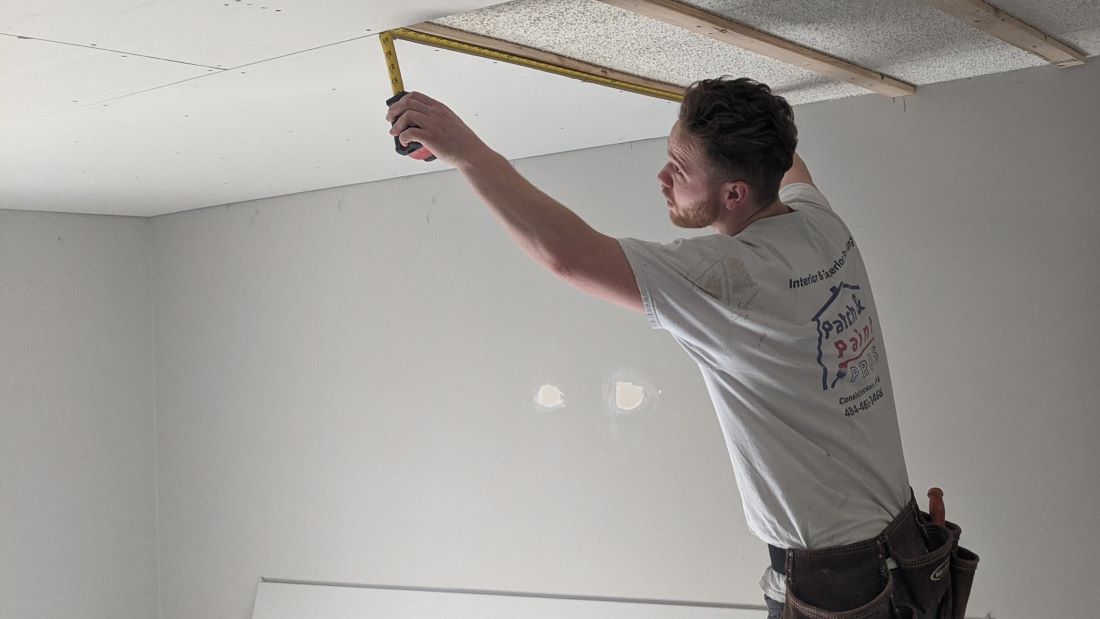Do you know how to spot a bad paint job? It’s not as straightforward as it may seem. A high-quality paint job should last for years, but if your contractor has used inferior materials or neglected important steps in the painting process, you could be dealing with bubbling and peeling paint far sooner than expected. But how can you tell when something is wrong?
We have some great news! In this article, we will share our top secrets on how to identify a poor-quality paint job and what to do about it. You’ll learn the signs of a bad painter so that you can avoid wasting time and money by ensuring that you get the best finish possible. We will cover topics such as discoloration from sunlight exposure, cracking caused by moisture damage, and other common indicators of substandard workmanship. So keep reading to find out more about these painting contractor secrets.
You don’t need to be an expert to recognize problems with your newly painted walls; all it takes is knowledge of the warning signs. The tips shared in this article are designed to help protect homeowners from costly mistakes and ensure they receive a high-quality service every time. With our helpful advice, no longer will you feel confused or misled by shoddy results – instead, you’ll know exactly what needs doing next!
What Is Paint Failure
Did you know that nearly 60% of painting projects fail within the first year? That’s right – one coat of paint can mean all the difference in how long your home looks great. But what causes these unfortunate cases of paint failure? In this section, we’ll discuss what happens when a coat of paint fails and how to identify signs of a faulty paint job.
The most common cause for a failed coat of paint is improper preparation or wear over time. If surfaces are not properly prepped before being painted, it can lead to bubbling, peeling, chipping, and flaking off shortly after application. Additionally, if the wrong type of paint thinner is used or the temperature is too hot during application, it will also result in poor coverage or adhesion. Flat paints tend to be more affected by incorrect prep work because their low sheen makes them more susceptible to dirt and dust buildup which will eventually weaken their grip on walls and other surfaces.
Identifying a faulty paint job isn’t always easy but some telltale signs could indicate trouble lurking underneath the surface. A few things to look out for include discoloration around edges, blisters forming along brush strokes, or brush bristles sticking up through the topcoat. These issues should be addressed immediately so they don’t worsen with time as further damage may occur if left unchecked. Knowing what to watch out for and taking steps to prevent any possible problems from occurring is key in ensuring that your next painting project lasts well into years down the road!
How To Identify A Faulty Paint Job
When it comes to identifying a faulty paint job, there are some simple steps you can take. Start by looking for signs of bubbling or peeling and if found, use a putty knife to test the area. If the paint easily lifts off in one piece then it’s likely been improperly applied and should be replaced immediately. Additionally, inspect trim pieces around windows and doors as these areas tend to show wear more quickly than other surfaces due to frequent contact with objects such as window sills or doorknobs. If any cracks or chips are present, scrape away old layers of paint using a putty knife before applying fresh coats.
It’s also important to check for an even sheen throughout your walls; unevenness could mean that too thick of a coat has been used in spots which will lead to premature fading or cracking down the road. Lastly, look out for brush strokes – they should appear uniform and create a smooth finish when viewed from different angles. A good way to ensure this is by running your finger along each stroke – if bumps are felt then reapplication may be necessary.
With all these tips in mind, you’ll have the confidence needed to identify any potential issues early on and make sure that your next painting project looks perfect for years to come!
Types Of Paint Damage
It’s estimated that every year, about 40% of all paint jobs fail due to improper techniques or outdated materials. This means it’s important for homeowners and contractors alike to be aware of the types of damage that can occur when painting.
The most common type of damage is brush marks, which occur when a person uses the wrong kind of brush or applies too much pressure while painting. Plastic brushes tend to leave streaks in the finished product, so avoid them if possible. Additionally, canvas cloths are better than synthetic ones because they don’t snag on rough surfaces and create small grooves.
Another issue is called ‘flashing’ – this occurs when two coats overlap during application creating an uneven sheen across your walls. To prevent flashing from occurring, ensure each layer has dried completely before applying another coat, and use even strokes with a good-quality brush. If you are still worried about getting professional-looking results then consider hiring a painter who knows how to properly use tools and apply multiple layers without causing any damage.
By understanding what causes these issues, you’ll be able to spot potential problems before they arise and take steps to correct them quickly before more costly repairs become necessary!
Warning Signs Of Poor Quality Paintwork
When it comes to painting, one of the most important factors is quality. Poorly done paintwork can lead to a multitude of issues down the road and even make your home look worse than before you started. To ensure that your next project turns out perfectly, here are some warning signs to watch for when inspecting existing or newly-painted surfaces:
• Visible Damage – Any visible damage such as chipping, cracking, bubbling, streaking, or peeling could indicate a problem with the underlying substrate, bad application techniques, or low-quality materials. The spackling compound should be used to fill in any cracks or holes before painting.
• Wet Paint – If the paint still feels wet after several days then it’s likely not properly cured and may have been applied too thickly which can cause problems like blistering and flaking down the line.
• Expensive Paints – In general, expensive paints often offer better coverage but there’s no guarantee they’ll hold up over time if not applied correctly – so be sure to ask questions about how it was applied before investing in higher-grade products. By being aware of these potential pitfalls ahead of time, homeowners can save themselves from costly repairs later on!
Causes Of Paint Deterioration
It’s not just poor quality materials and application that can lead to paint deterioration, however. Improper storage of cans of paint or incorrect mixing ratios can also be to blame for a lackluster finish. Additionally, not removing excess paint during the job can cause future problems like cracking or flaking due to loose particles settling over time.
Cans of paint should always be stored in cool, dry areas away from direct sunlight to minimize chemical reactions caused by heat exposure. When it comes time to mix paints, make sure the correct ratio is used (usually 1:1) so that there are no inconsistencies in the final product. Finally, any leftover material should never be left on site; instead, dispose of it properly or return it back to its original container for later use.
Taking these precautions will help ensure your surfaces look as good as new down the road!
Common Mistakes Made By Contractors
As a painting contractor, there are certain mistakes that you need to be aware of to avoid putting your clients at risk and ensure quality results. One such mistake is thinking cutting corners by using cheaper materials or skimping on the amount of paint used is a false economy; ultimately it will lead to issues down the road as these products won’t stand up to wear and tear. Additionally, not allowing enough drying time between coats can also cause problems like bubbling or peeling, so make sure every layer has had ample opportunity to dry and cure before moving on.
When working with paints, it’s essential to avoid mixing an incorrect ratio of solvents and pigments. While it may seem like a shortcut, it can lead to poor finishes with inconsistent coloration, which no client wants to see. To achieve optimal results, it’s crucial to measure ingredients carefully. Additionally, applying excessive pressure while brushing or rolling onto surfaces can leave behind undesirable marks, so it’s crucial to use all tools accordingly to ensure smooth coverage every time. If you do end up with paint on metal surfaces, it’s important to know how to remove paint from metal properly to avoid damaging the surface.
By avoiding these errors, contractors can have peace of mind knowing their projects will turn out just as expected!
Tips For Finding A Reputable Painting Contractor
Achieving a professional-looking paint job requires finding the right painting contractor for your project. While there are many to choose from, it’s important to take some time in order to make sure you’re getting the best one for your needs. Here are some tips that can help when selecting a professional painter:
First and foremost, do your research. Ask friends or family members if they have any recommendations; check online reviews as well. You should also contact at least two contractors before deciding so you can compare prices and services offered. This will ensure that you get the most value for your money!
Once the potential candidates have been identified, ask them questions about their experience and qualifications. It is also wise to request references from previous clients so you can gauge how they handled similar projects in the past. Finally, don’t forget to inspect samples of their work – this way you’ll be able to visualize what kind of results you could expect from hiring them.
By considering all these steps, homeowners can rest assured knowing that their home improvement project is being entrusted to someone who knows exactly what they’re doing with a damp cloth!
Final Thoughts
The quality of a paint job is essential to any house’s appearance and longevity. Knowing the warning signs of poor-quality paintwork and how to identify faulty painting jobs will help you get the best results from your painter. It’s important to educate yourself on common mistakes made by contractors, causes of paint deterioration, and how to find a reputable contractor so that you can make sure your home looks great for years to come.
Imagining a vibrant colorful home with beautiful details throughout can be quite inspiring when it comes to finding the right contractor for your needs; one who has an eye for detail as well as expertise in their craft. A good painter should have knowledge about different types of paints, various techniques used in painting, and ways to prevent future damage or fading in order to give you peace of mind knowing that your investment was worth every penny.
By following these tips, you can ensure that not only do you get a stunning result but also avoid costly repairs down the line due to improper painting techniques or inferior products being used. With this information at hand, rest assured that no matter what project you decide on tackling next – whether it’s exterior or interior painting – you’ll have everything necessary under control!











